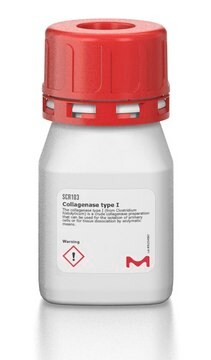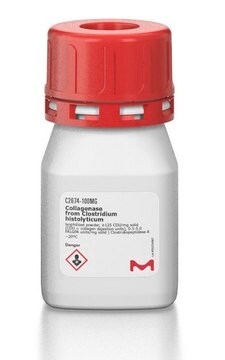C7926
Colagenasa from Clostridium histolyticum
Sigma Blend Type F, ≥2.0 FALGPA units/mg solid
Sinónimos:
Clostridiopeptidasa A
Iniciar sesiónpara Ver la Fijación de precios por contrato y de la organización
About This Item
Productos recomendados
biological source
Clostridium histolyticum
Quality Level
form
powder
caseinase activity
≤10 units/mg solid
specific activity
≥2.0 FALGPA units/mg solid
mol wt
68-130 kDa
storage temp.
−20°C
¿Está buscando productos similares? Visita Guía de comparación de productos
Application
Collagenase from Clostridium histolyticum has been used in determining the degradation rate of collagen biomaterials. It may also be used to determine the enzymatic degradation and enzymatic resistance by the liberated L-leucine measurements.
Collagenase from Clostridium histolyticum, or Clostridiopeptidase A, has been used in a study to assess contact dermatitis with clostridiopeptidase A contained in Noruxol ointment. Clostridiopeptidase A has also been used in a study to investigate the early and successful enzymatıc debridement via collagenase application to pinna in a preterm neonate.
The enzyme has been used in the isolation of mast cells from adult mice. This study generated a large number of connective tissue-type mast cells by the culture of murine fetal skin cells. The product has also been used in the in vitro biodegradation study of Bombyx mori silk fibroin fibers and films, by exposing them to the enzyme for varied time periods.
Biochem/physiol Actions
La colagenasa es activada por cuatro átomo-gramos de calcio por mol de enzima. Es inhibida por el ácido etilenglicol-bis(beta-aminoetil éter) - N, N, N′,N′-tetraacético, el beta-mercaptoetanol, el glutatión, el ácido tioglicólico y la 8-hidroxiquinolina.
Effective release of cells from tissue requires the action of collagenase enzymes and the neutral protease. Collagenase is activated by four gram atom calcium (Ca2+) per mole enzyme. The culture filtrate is thought to contain at least 7 different proteases ranging in molecular weight from 68-130 kDa. The pH optimum is 6.3-8.8. The enzyme is typically used to digest the connective components in tissue samples to liberate individual cells. Ethylene glycol-bis(β-aminoethyl ether)-N,N,N′,N′-tetraacetic acid (EGTA)4; β-mercaptoethanol; glutathione, reduced; thioglycolic acid, sodium; and 2,2′-dipyridyl; 8-hydroxyquinoline are known to inhibit the enzyme activity.
Unit Definition
Una unidad de digestión de colágeno (CDU) libera péptidos del colágeno del tendón de Aquiles bovino que equivalen en la reacción de color de la ninhidrina a 1,0 μmoles de leucina en 5 horas a pH 7,4 y 37 °C en presencia de iones calcio. Una unidad de hidrólisis FALGPA hidroliza 1,0 μmoles de furilacriloil-Leu-Gly-Pro-Ala por minuto a 25°C. Una unidad de proteasa neutra hidroliza la caseína para producir color equivalente a 1,0 μmoles de tirosina por 5 horas a pH 7,5 y 37°C. Una unidad de clostripaína hidroliza 1,0 μmoles de BAEE por minuto a pH 7,6 y 25°C en presencia de DTT.
signalword
Danger
hcodes
Hazard Classifications
Eye Irrit. 2 - Resp. Sens. 1 - Skin Irrit. 2 - STOT SE 3
target_organs
Respiratory system
Storage Class
11 - Combustible Solids
wgk_germany
WGK 1
flash_point_f
Not applicable
flash_point_c
Not applicable
ppe
dust mask type N95 (US), Eyeshields, Faceshields, Gloves
Elija entre una de las versiones más recientes:
¿Ya tiene este producto?
Encuentre la documentación para los productos que ha comprado recientemente en la Biblioteca de documentos.
Los clientes también vieron
Properties of collagen and hyaluronic acid composite materials and their modification by chemical crosslinking
Rehakova M, et al.
Journal of Biomedical Materials Research, 30(3), 369-372 (1996)
Biodegradation of Bombyx mori silk fibroin fibers and films.
Arai T, et al.
Journal of Applied Polymer Science, 91(4), 2383-2390 (2004)
Nobuo Yamada et al.
The Journal of investigative dermatology, 121(6), 1425-1432 (2003-12-17)
We describe a novel culture system for generating large numbers of murine skin-associated mast cells and distinguish their characteristics from bone marrow-derived cultured mast cells. Culture of day 16 fetal skin single cell suspensions in the presence of interleukin-3 and
K Vizárová et al.
Biomaterials, 16(16), 1217-1221 (1995-11-01)
Two kinds of layered atelocollagen materials cross-linked with hexamethylene diisocyanate (HMDIC), starch dialdehyde and glyoxal were enzymatically treated by bacterial collagenase. Evaluating collagenase digestion assay for these material showed progressive differences, particularly in the group of samples cross-linked with HMDIC.
Tyler J Chozinski et al.
Scientific reports, 8(1), 10396-10396 (2018-07-12)
Although light microscopy is a powerful tool for the assessment of kidney physiology and pathology, it has traditionally been unable to resolve structures separated by less than the ~250 nm diffraction limit of visible light. Here, we report on the optimization
Nuestro equipo de científicos tiene experiencia en todas las áreas de investigación: Ciencias de la vida, Ciencia de los materiales, Síntesis química, Cromatografía, Analítica y muchas otras.
Póngase en contacto con el Servicio técnico


![N-[3-(2-Furyl)acryloyl]-Leu-Gly-Pro-Ala](/deepweb/assets/sigmaaldrich/product/structures/805/876/96b5fb57-71c8-4c6b-b5d2-fafe7374cd85/640/96b5fb57-71c8-4c6b-b5d2-fafe7374cd85.png)




